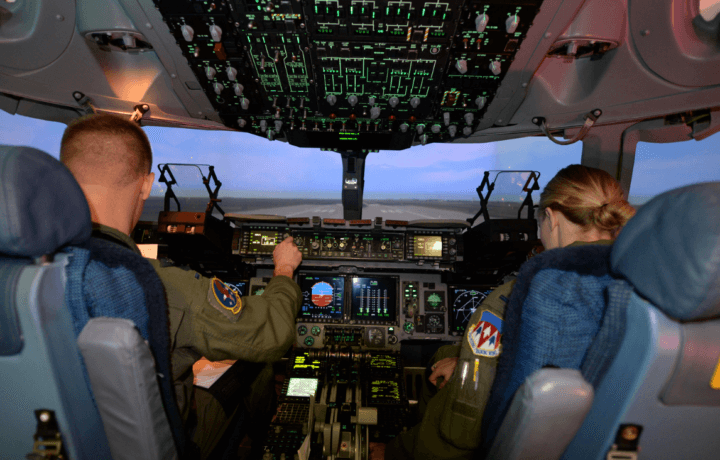In March, officials from the United States Air Force told lawmakers on the House Armed Services subcommittee on readiness that at the end of the last fiscal year, the service had a pilot shortage of about 2,100 or roughly 10% of the 21,000 pilots it needs to execute the National Defense Strategy. That included 950 in the active-duty Air Force, 650 in the Air National Guard, and 500 in the Air Force Reserve.
Since that time things have gotten only slightly better.
New Initiatives to Address the Pilot Shortage
Last month it was reported that the service has arrested the downward trend in pilot manning through new initiatives to increase “pilot production,” such as through the Pilot Training Next virtual reality (VR) and artificial intelligence (AI) program.
This month, the Air Force announced the inauguration of the new Virtual Test and Training Center (VTTC) at Nellis Air Force Base (AFB), NV—which will house the future of joint-aerial combat training. The VTTC will utilize the facility so that pilots can simultaneously train together in both live and virtual environments.
“It’s a significant step forward to enable testing tactics development and advanced training for the Air Force, joint and coalition partners,” said Peter Zupas, U.S. Air Force Warfare Center (USAFWC) operational training and test infrastructure analyst via an Air Force statement.
The first missions to be conducted at the VTTC are scheduled to begin around spring or summer of 2021. The $38 million center will allow Air Force pilots to practice advanced tactics that can replicate combat against near-peer nations and other adversaries.
“In the next year or so we will officially have it up and running,” added Col. Dean Caldwell, the USAFWC VTTC director. “The VTTC will then be turned into a squadron and be placed under the Nevada Test and Training Range.”
Pilot Training 2.5
Another part of the Air Force’s efforts is to be almost less “militarily rigid” about the training efforts. AI and VR technologies, along with increased simulator time are also being adopted to allow student pilots to better progress at his own pace and this is being explored in the Undergraduate Pilot Training 2.5 program.
Air Force Magazine reported that newly-minted Chief of Staff Gen. Charles Q. Brown Jr. and Chief Master Sergeant of the Air Force JoAnne S. Bass recently joined service Secretary Barbara M. Barrett on a trip to Air Education and Training Command in Texas for a first-hand look at the program and to see how these technologies can be used to train the pilots of tomorrow.
While the ongoing pandemic has caused a bit of a slowdown in the production of pilots, VR and AR are also tailor-made to handle the need to social distance. Air Education and Training Command (AETC) had expected to produce between 1,350 and 1,400 pilots in fiscal 2020 – which is likely to be closer to 1,200, due to the learning curve and working out any issues with the program.
“We’re proud of innovative efforts such as Pilot Training Next and the just-launched UPT 2.5 program,” said Maj. Gen. Craig Wills, Air Education and Training Command’s 19th Air Force commander earlier during a visit from Gen. Mike Holmes, the commander of Air Combat Command.
“There’s no question we still have a lot of work to do in order to fully transform our training programs,” Wills added. “We have an imperative to continually improve the capability of our graduates in order to ensure our Air Force remains the world’s best.”
Industry Support
The new programs could help the Air Force close its pilot shortfall, but this could also be good news for its private sector partners. In August, CAE USA was awarded a contract from the Defense Innovation Unit (DIU) to support both the AETC and its UPT 2.5 initiative.
The company will be responsible for the installation and integration of a cloud-based Learning Management System (LMS), which is a key element of the CAE Trax Academy pilot training continuum. The LMS will enable the Air Force and its students to access training content such as schedules, courseware, and remote instruction more easily on demand.
The LMS will be optimized through artificial intelligence (AI) and machine learning, which will enable Air Force to create a pilot training process that is continually adapting and improving. The Air Force also intends to develop an AI flight instructor that would provide active and passive instruction to aid student learning and progression through the pilot training syllabus.
“We are excited to be part of the U.S. Air Force’s Pilot Training Transformation efforts and offer some of CAE’s training systems integration expertise,” said Ray Duquette, President and General Manager, CAE USA. “We have been focused in recent years on making investments in digital technologies and data analytics that will help our military customers produce pilots faster and more efficiently. We look forward to progressing on this journey in partnership with the U.S. Air Force.”




